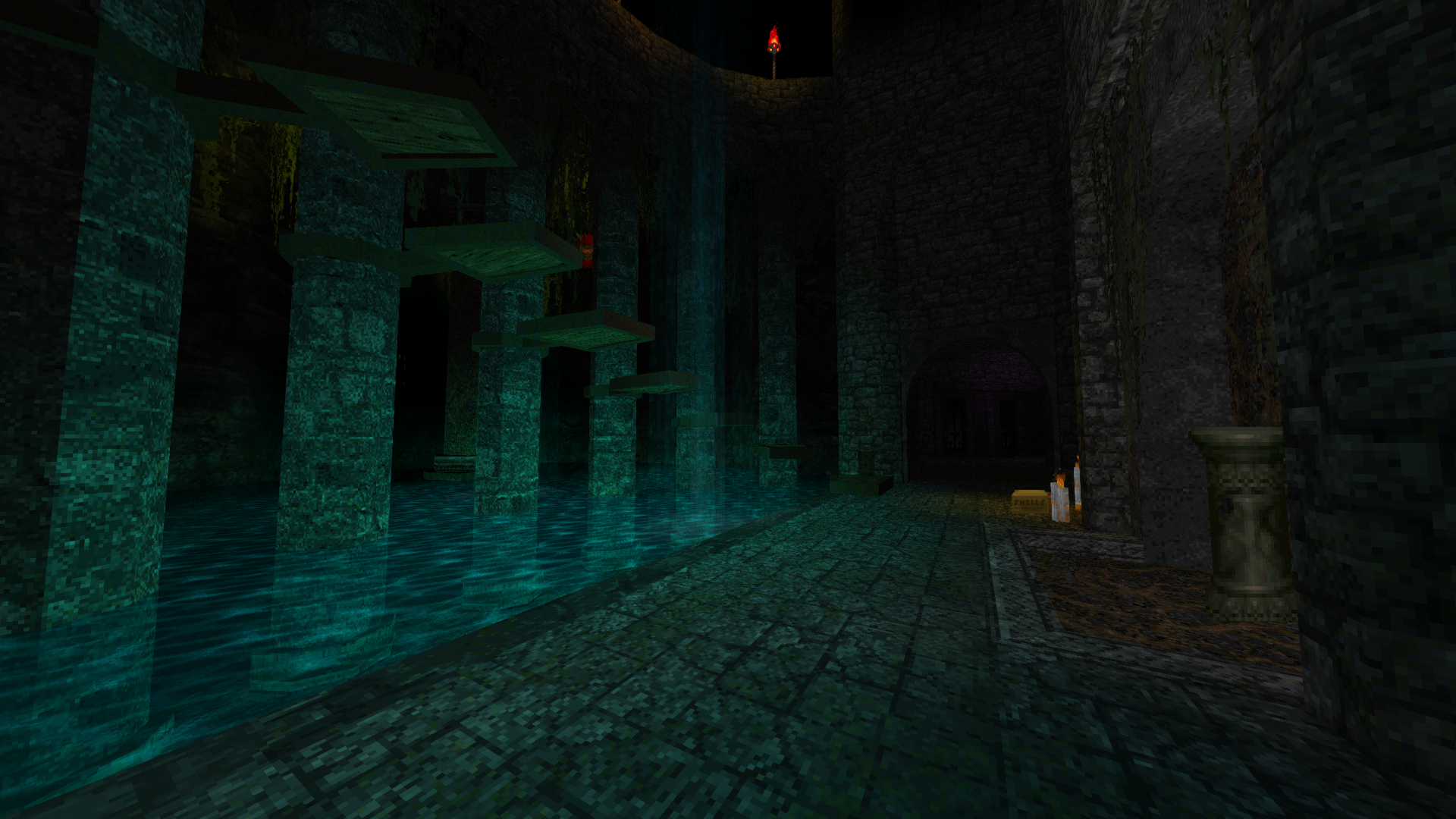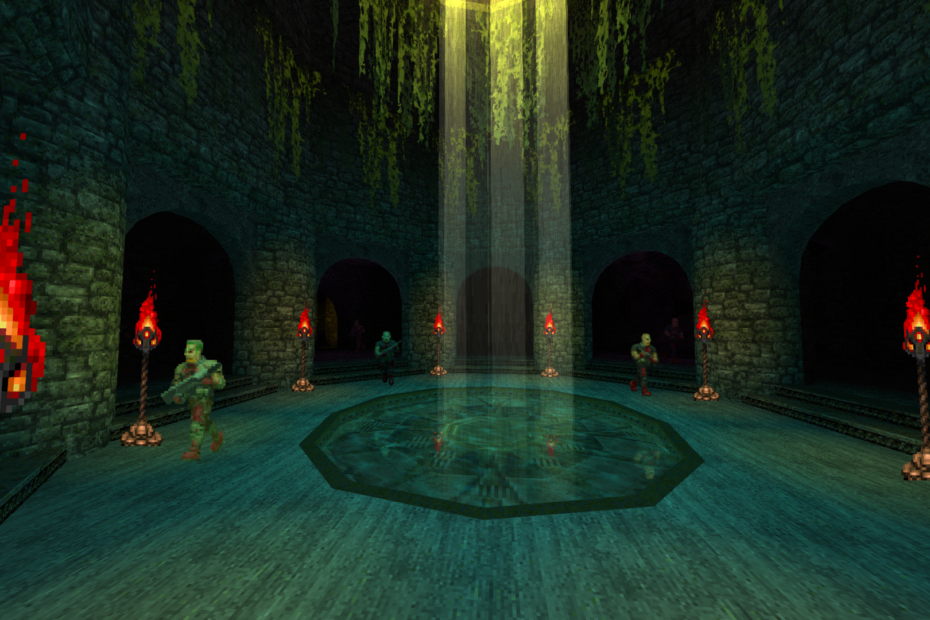July 20, 2022
- WAD by Christopher Lutz
- Published in 2022
- Doomworld thread
In a community as old and veteran as Doom, it is relatively common to find active members who started their first steps in the golden age of the game. Some veterans keep in their footsteps by being highly active through their favorite content, while others tend to be more focused on rearing their heads from time to time with fantastic surprises that rock our socks off. Christopher Lutz is one of those who falls into the latter category. A map designer who was part of the old Chaos Crew, back in the days when forming teams of mappers was common practice. With his first WAD being a cool episode for Ultimate Doom, released in 1998, Lutz would not stop even to this day. Winner of several Cacowards and developer of fantastic levels that combine modern sensibilities with vanilla charisma, Lutz is an iconic member and more than qualified to be mentioned as one of the best. Need proof of that? Corrupted Cistern is here to prove it.
A single-level WAD for GZDoom, this machine of a map proves that there’s far, far greater themes and visual styles left to be explored and showcased with the power of UDMF. Inspired by the classic Unreal video game, Lutz designed a level that re-imagines the natural and wet style of Unreal, with a new gothic touch and the classic Doom influence, creating a map that is incredibly attractive, atmospheric, and beautiful to look at. Detailed and combining rock structures with the morphology of a cavern, the result is simply iconic, to the point that each scene is more than worthy of being a wallpaper in itself. Unreal is a unique and fascinating game, renowned for its outdoors levels. Doom, on the other hand, has always suffered a bit with maps that are implicitly set in natural areas. With the limitations of the engine lifted and the new UDMF features, an artist with enough skill can recreate that fantastic sense of exploration and discovery that Unreal possessed. Lutz has managed to create just that with Corrupted Cistern.
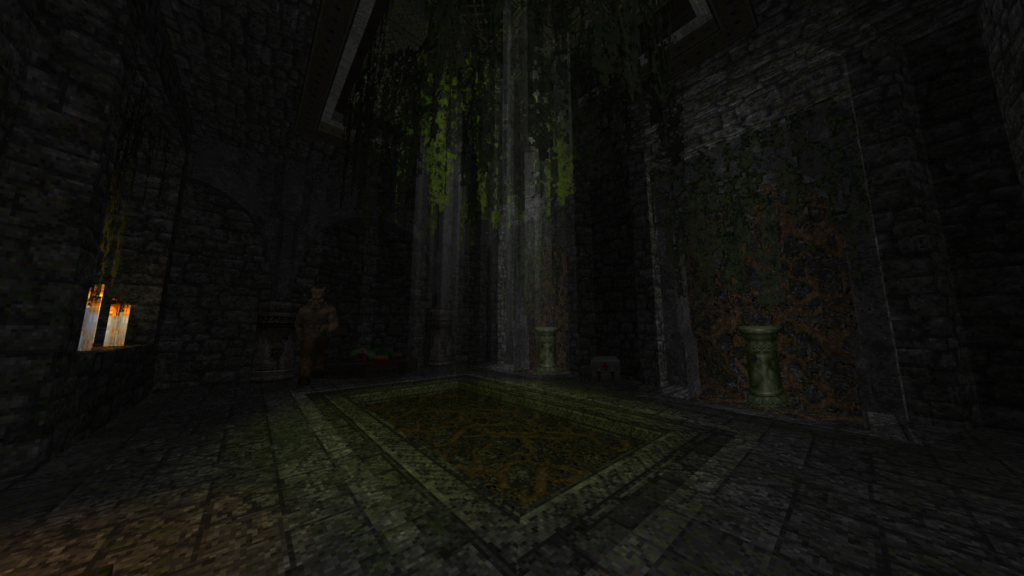
The use of curves, slopes, and realistic geometry, as well as a detailed design that inspires realism, creates a sense of immersion quite attractive, which captures me thanks to its visual solidification. The structure transposes through the natural development of the cave, combining the design of bricks and polished rock with the cave, water, moss, and trees, giving it a quite unique and different touch that remains well done around the entire map, without exceptions. The scenes are simply inspiring to watch. If you are a fan of Unreal, you will definitely be satisfied with the great level of detail and design that this map has.
The combination of liquids is something that stands out to me. Lutz creates multiple natural and designed areas with water in between. Canals, sewers, wells, or small natural pools, as well as waterfalls and subway rivers. That’s why it’s called a cistern! And it manages to create that evocation that we believe ourselves in a kind of natural subway reserve, now under the possession of demons in a forgotten ruin.
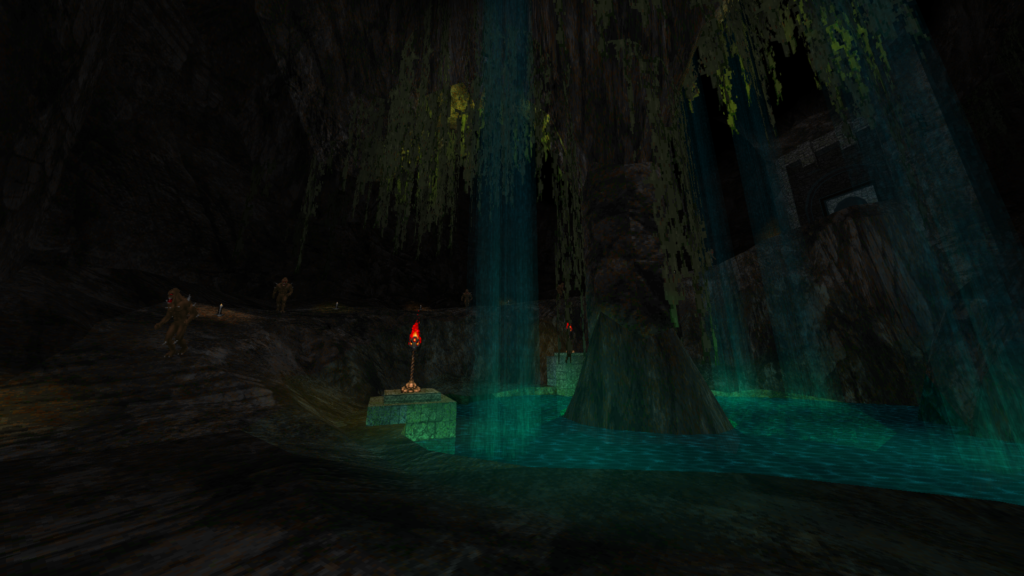
The layout of Corrupted Cistern is designed to offer a fairly complex and deep adventure. The map is non-linear, with different routes and paths to take, as well as secret areas and places to explore. On the other hand, it is relatively easy to navigate due to its cohesive design and direction. All paths will lead you to a place of importance, so it doesn’t matter too much to get lost when you can always end up gaining something new and useful.
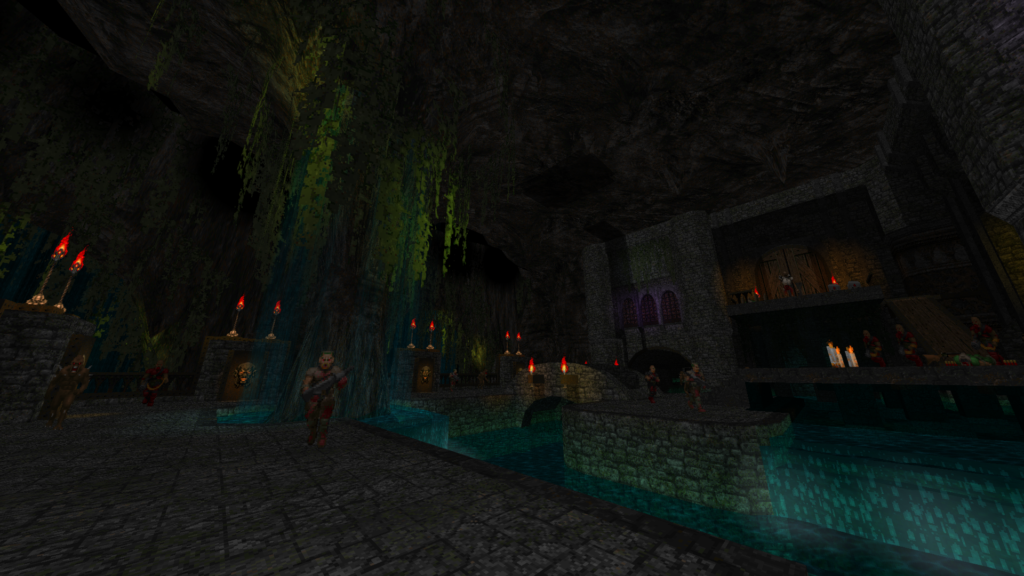
The gameplay offers a considerable variety of encounters, perfectly balanced so that every type of player can take a spin on the map. From the traditional encounters with hitscanners defending roads, to a variety of areas where different traps await us, either through Cacodemon swarms or a rogue final boss. This map not only looks great but plays great too! Too bad it doesn’t have more custom stuff, like new music or status bar, but that’s just being nitpicky.
Corrupted Cistern is a deep and enigmatic experience. A map that takes you to the heart of an abandoned and neglected world. With Lutz’s sensibilities, we have as a result a great UDMF work that checks all the quality boxes, ready to give you an adventure hard to forget.
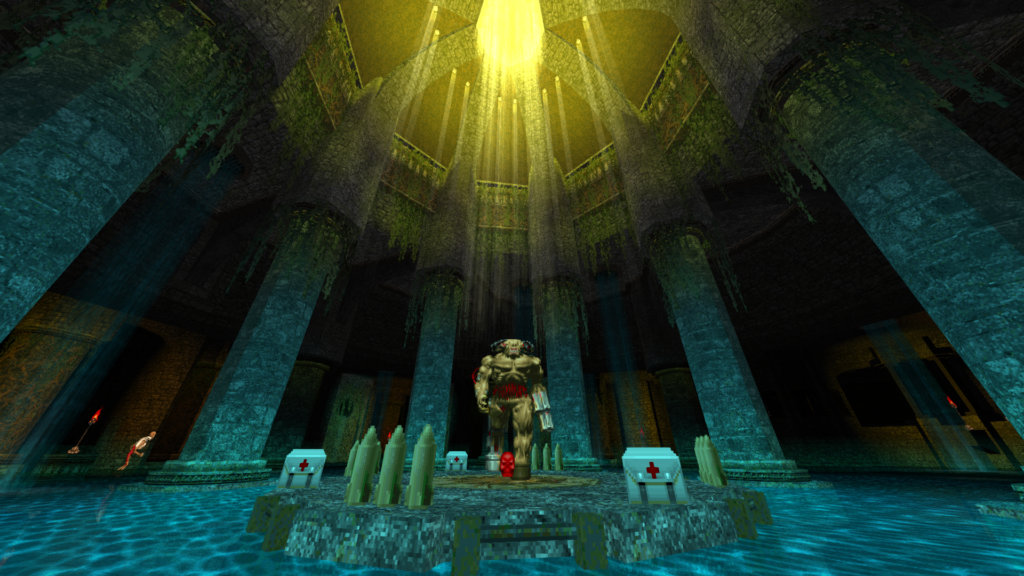
But now, let’s hear it from the legend himself, please, let’s welcome, Christopher Lutz!
- Lutz! A community veteran with a lot of aces up his sleeve. Tell us, how does your history with Doom begin?
First of all, thanks for the invite – who doesn’t love a chance to talk about him/herself?
Secondly, it’s a good thing I have never tried to hide just how old I am relative to most in this community, since I would otherwise have to lie through my teeth to answer this question. And finally: I purchased the shareware version of Doom on a 3.5” disk from Staples (an office supply store) while walking home from school in the Spring of 1994 at the tender age of 15. Shortly thereafter, I sent Id Software money – in the mail! – for the full version (1.2 at the time, as you can see in the image below).
As is probably obvious, I absolutely loved it from the very first moment – it was technically amazing, gorgeous, terrifying…and really, really fun. I’ve shared these memories on Doomworld.com before, so apologies if I’m retreading old ground, but there are three that truly stand out:
1) I can vividly remember just staring out the window at the top of the first E1M1 staircase; something about the mountainous sky and shadowed plain echoed with melancholy beauty, and the fact that you couldn’t get out there added greatly to the mystique.
2) For an embarrassing amount of time, I was legitimately frightened by E1M7 since I didn’t realize that there were enemies on top of the small raised area in the middle of the map – I could hear the alert noises of the monsters, but I had no idea where they were and it scared the crap out of me.
3) I didn’t have (dial-up) internet at the time, so in order to glean info about secrets and shortcuts, I would surreptitiously browse the printed strategy guides at various bookstores and scribble down notes – I definitely recall having to read about the way to get to the secret level in Episode 3, and having to go back at least twice to accurately record “idspispopd.”
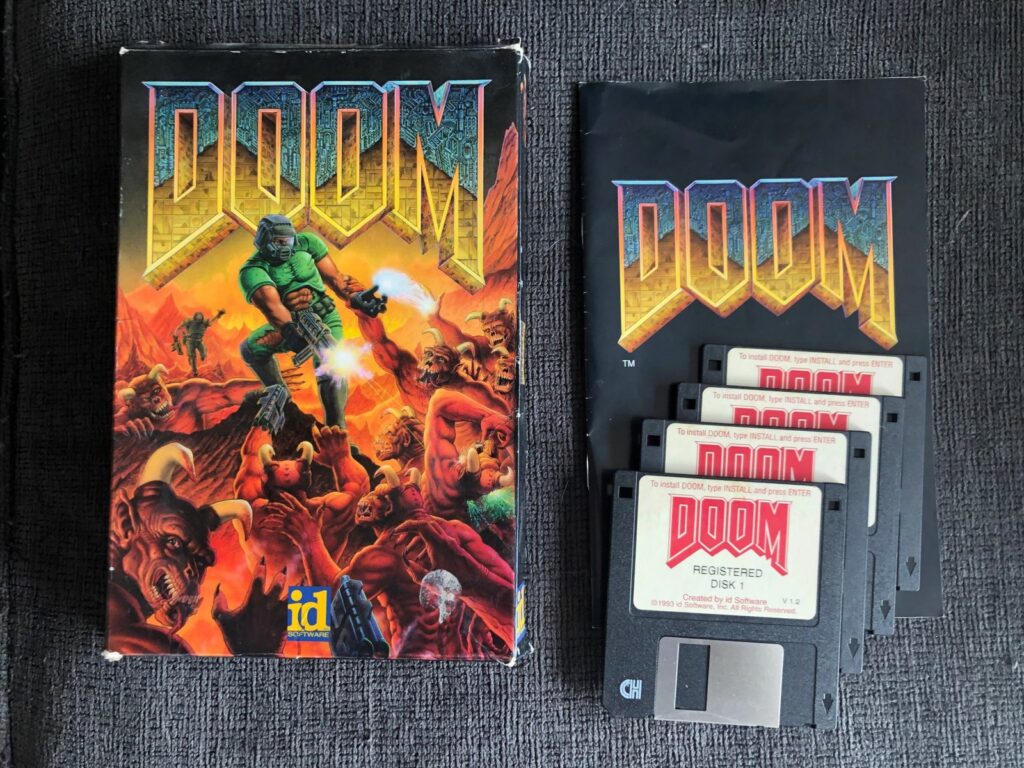
- How was your initial experience creating maps?
Painful and frustrating. Again, as someone attempting to learn the basics prior to the proliferation of the internet, I was reliant on whatever information I could glean from editor ReadMe files (which were very much an afterthought). To illustrate how ignorant and ill-informed I was, I can vividly remember the moment I realized that ceiling/floor textures were aligned with the 64×64 grid – I had previously spent a very frustrating evening attempting to construct a teleport pad and just could not get the GATE texture to appear in the right spot…
- What is the history of Chaos Crew?
My history with the Chaos Crew began when Gregory Jackson reached out to me following the release of “Inferno” – he wanted to know if I would be interested building levels for a project he had in mind that would take advantage of the newly-release BOOM engine. I had no particular projects in the works, so I agreed.
After a few back-and-forth requirements/idea e-mails with Gregory and Joel Murdoch, I started laying down some sectors. Once I had a couple rooms – a starting teleport pad and a rough outdoor area with a small pool of deep water (revolutionary!) – I sent it out for review…which didn’t go well. Gregory was disappointed because it didn’t match his vision at all, but he thought it might be okay for another project he was in the early stages of developing: Caverns of Darkness. Obviously, we proceeded with COD.
(For the record, I honestly don’t remember anything about the original project he pitched.)
- What happened that you did not create more maps as a team?
That’s a great question, and one for which I don’t have a definitive answer. I can tell you that my life was incredibly busy after the release of COD – I was graduating college, moving, and starting graduate school – so I was hesitant to commit to anything I wouldn’t be able to adequately support (I suspect it was the same for the others as well, but I don’t want to speak for them).
- Who has inspired or instructed you in level design?
For the record, this question is incredibly unfair because there are far too many wonderful folks to actually list. Nonetheless (and to hammer home the fact that I am old):
Iikka Keränen was the first author I really remember admiring because “Dystopia 3” shattered my perceptions of what was actually capable with the vanilla Doom engine. Likewise, Sverre Kvernmo’s work in “Eternal Doom” was incredibly influential – those levels are still excellent examples of visual storytelling for which I have great respect. In a similar vein, the Boom version of “The Artifact” by Paul Schmitz did for that engine what “Dystopia 3” did for the vanilla engine while also presenting a cohesive region spread over 3 levels. Finally, I have to mention Justin Fisher and his “Aliens TC” for illustrating the transformative power of DeHacked editing.
…and of course: John Romero, Sandy Peterson, Tom Hall, and American McGee.
- What do you think about the progress of the community over the years?
In short: absolutely amazing. Personally, there are very few things in my life that have been around as long as the Doom community, and I am quite grateful that the community is still flourishing.
- What are your favorite WADs?
Like question #5, this is damn near impossible (and, thanks to the active community, changes with some frequency), but here the levels I always enjoy revisiting:
- E1M3/E1M5/E3M3/E3M7
- Eternal Doom
- Alien Vendetta
- Ancient Aliens
- Action Doom
8. To this day, you still create levels, what inspires you or gives you energy to stay active despite the decades?
Level editing is to me today what Legos were as a kid: a free-form construction sandbox in which part of the challenge is using a fundamentally finite set of elements to create something new, beautiful, or unexpected. There is something incredibly satisfying about the process of fashioning a (digital) world, and watching it emerge from the elusive, half-formed wisps of thought. In short, I simply enjoy building levels – the fact that others care to play them is also pretty cool, too, but not the reason I keep at it.
- Which of your maps/WADs are you most proud or satisfied with?
I am quite pleased with “Corrupted Cistern” because it was my first foray into the vast unknown that is GZDoom /UDMF, so I had to learn quite a few new skills (and a new editor)…but despite that, it is one of the few levels that ended up looking and playing pretty close to what I originally planned. I am also pretty proud of “Perdition’s Abyss” from COD and E3M7 from “Inferno” because (IMHO) they both look good and have some pretty fancy special effects for the times in which they were released. That said, I think “Hellscape” is still my best work from start-to-finish.
- If you could go back in time and talk to the Lutz of yesteryear while designing levels, what would you tell him?
“Hey, idiot – don’t be afraid to learn the new stuff.”
Looking back, there were definitely various times during my mapping history I was intimidated almost to the point of inaction simply because I would have to learn something new (e.g. adding custom textures/graphics; BOOM/MBF special effects; tinkering with GZDoom/UDMF). Part of that hesitancy could be charitably blamed on a desire to ‘color within the lines’ (i.e. work within the restrictions of what I considered the base engine and resources to be), but if I’m honest, that’s probably bullshit. I definitely am self-aware enough to realize that part of the reason I am drawn to Doom is the fundamental simplicity which helps temper my natural perfectionist tendencies – otherwise I would be the guy modelling individual bolts on an elbow joint outside the player’s FOV – but I’m certain I would be a better mapper today if I had started expanding my skill-set earlier.
(As an aside: this is a truly fascinating question, and I spent way more time trying to answer it than any other.)
- Icebound is one of your few levels created for Heretic, what can you tell us about it? Do you play Heretic a lot?
While I believe it artistically equal (albeit in a brighter, more cartoonish way), at the end of the day I find Heretic to be simply less fun than Doom for reasons that I struggle to articulate. As such, I play it more for visual inspiration and nostalgia than pure enjoyment. “Icebound” was an attempt to dive in and learn about Heretic’s mechanics from a designer standpoint in hopes of better appreciating it from a player’s perspective – much like “Hellscape” was for the Doom II Hell levels – and to that extent it wasn’t much of a success. Still, I do really like the way it looks (and I’m pretty proud of the various effects in the room with the Phoenix Rod).
- Your last map is a masterpiece for the eyes, how was the development of Corrupted Cistern?
S-L-O-W. As previously mentioned, I was learning a new editor – which, though similar to DB2, required retraining some ingrained muscle memory – whilst also exploring the new effects and opportunities afforded by the engine, so I had a lot to juggle. (Fortunately, the Doomworld community is such that even my most idiotic questions received a thorough answer in rapid fashion, so I was rarely held up for too long.) And, as ought to be expected, with those new opportunities came several design choices I ended up rethinking and artistic dead-ends that required judicious pruning.
FYI, the level actually started as an attempt to vaguely re-create a single room of the “Temple of Vandora” Unreal map…and then sprawled out in many different directions from that single idea.
- Corrupted Cistern is your first adventure with UDMF, apparently! What made you make the jump?
Prior to starting “Corrupted Cistern” I had been working on a standard format (limit-removing) project with the “Ancient Aliens” texture set; it was humming right along until I hit the maximum line-/side-def limit in one of the maps (which I previously didn’t realize even existed). After some back-and-forth on the Doomworld forums, it became apparent that jumping to UDMF was really the only way to avoid that limit without removing geometry, so I started playing around with Ultimate Doom Builder. I suspect I will end up converting the levels I had made for the previous project over to UDMF (though I have yet to find a Doom-to-UDMF converter that retains texture alignments), but I have some other commitments to attend to first.
- What’s your favorite mapping format?
As liberating as UDMF is, there is something special about a well-constructed (limit-removing) Doom level. I may change my mind sometime in the future, but for now I am going to stick with classic format (minus visplane overflows – those just suck).
- Which modern/recent authors inspire you?
Again with the impossible questions.
Anyway, one cannot help but admire Paul “skillsaw” DeBruyne for the sheer number of quality levels he consistently generates; I am in awe of both his creativity, skill, and the speed with which he works. Also, Xaser is awesome – his lifetime achievement award is definitely warrented. Finally, the “Elementalism” and “Age of Hell” teams have done some amazing work expanding the boundaries of what is possible and generating some truly imaginative environments. …And I am certain that I will think of at least a dozen more folks as soon as I submit these answers.
- Any last words for the readers?
I am honored and humbled to be part of this amazing community; keep up the good work.
